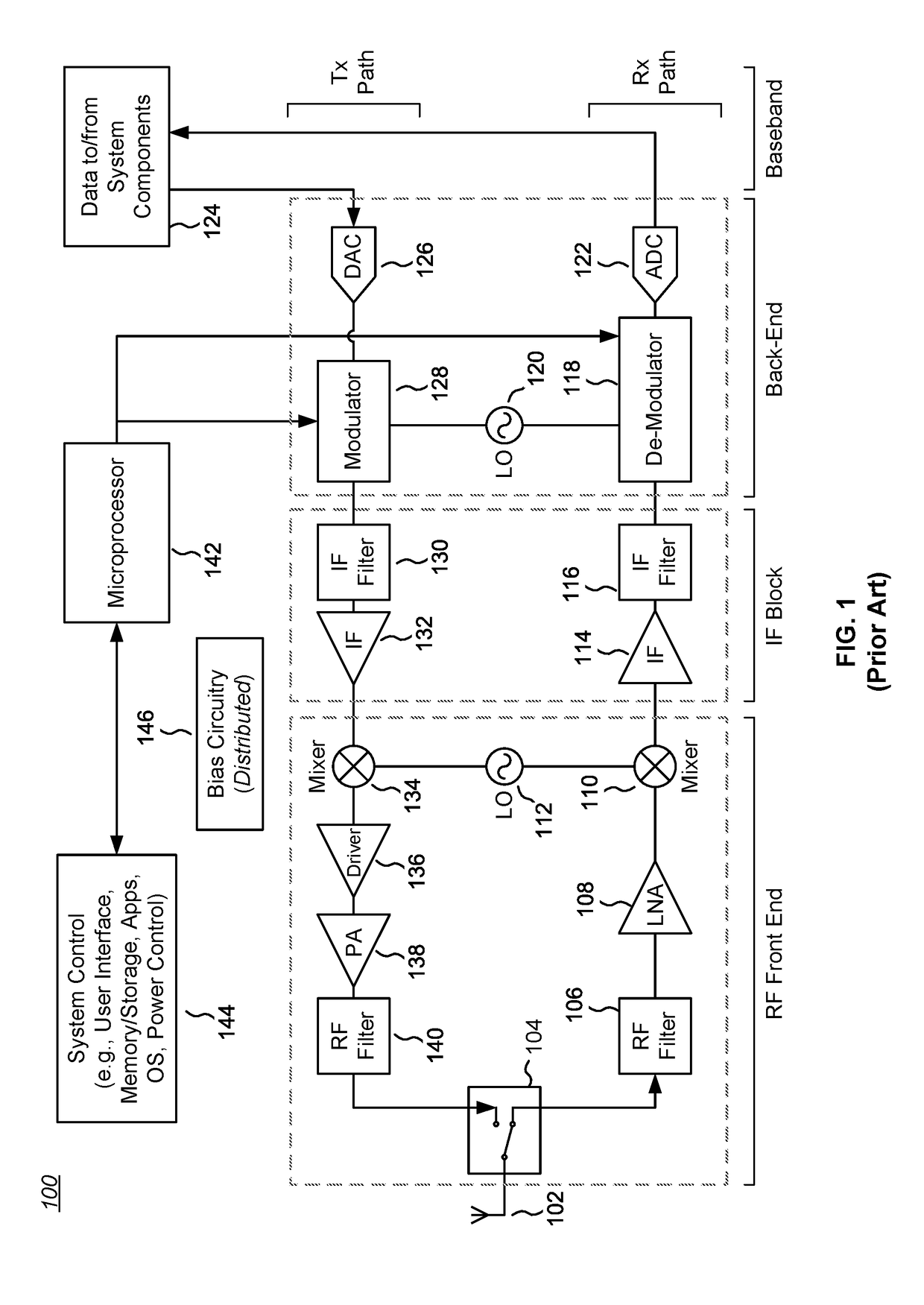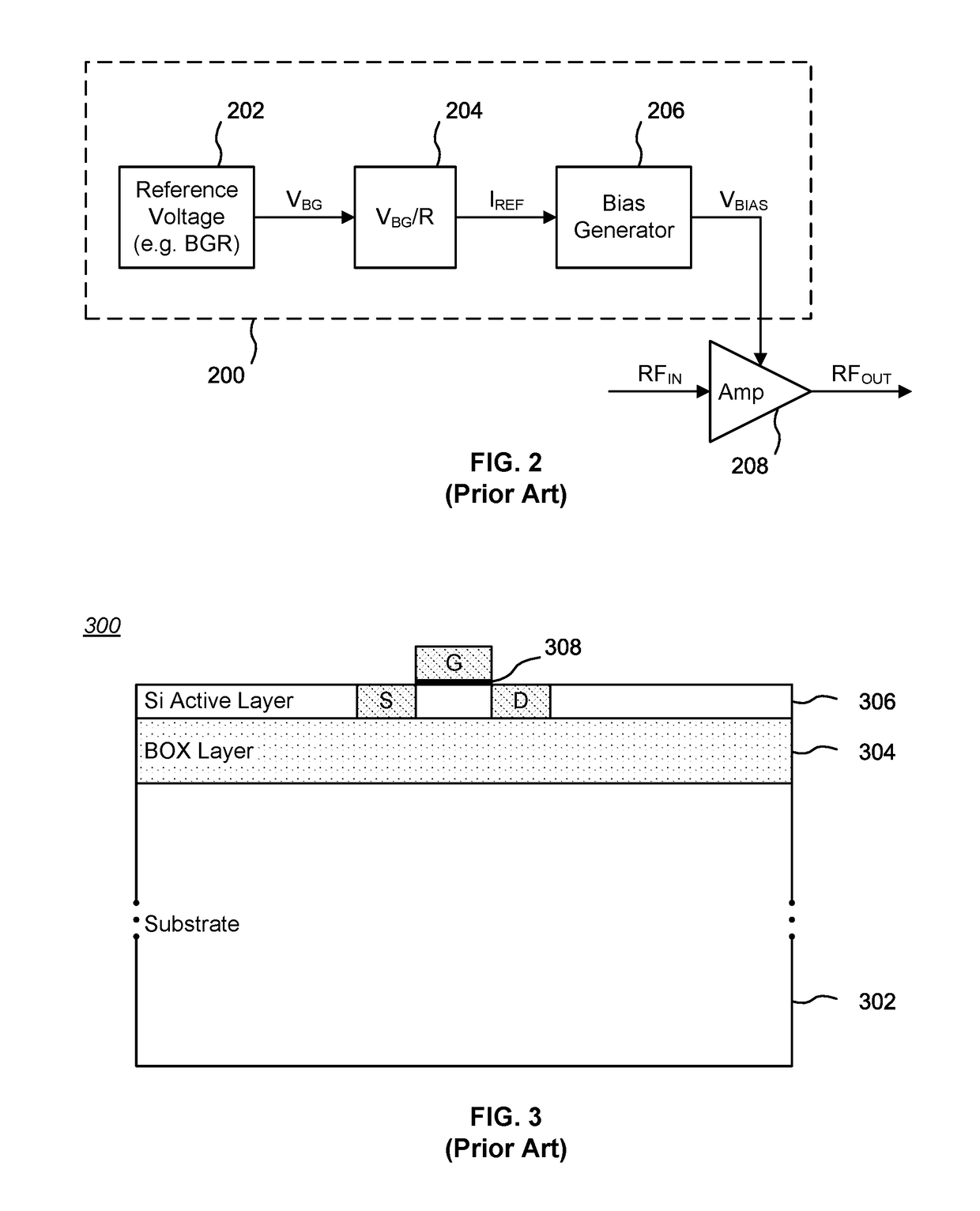Managed Substrate Effects for Stabilized SOI FETs
a stabilized substrate and substrate technology, applied in the field of electromechanical circuits, can solve the problems of complex switching and control, difficulty in optimizing operational parameters, and acute rf design, and achieve the effect of eliminating or managing accumulated charge and eliminating or mitigating the effects of such accumulated charg
- Summary
- Abstract
- Description
- Claims
- Application Information
AI Technical Summary
Benefits of technology
Problems solved by technology
Method used
Image
Examples
first embodiment
[0073]In a first embodiment, a trap rich layer is selectively formed on a high resistivity substrate.
[0074]FIG. 5A is a block diagram showing an in-process step in the manufacture of an SOI wafer 500 having a high resistivity substrate 402. In this example, a mask is used to define a trap rich region 502 on the high resistivity substrate 402 (shown truncated vertically, the actual proportions would more typically resemble FIG. 4). The trap rich region 502 is otherwise formed on the high resistivity substrate 402 in a conventional manner in a pattern defined by the mask.
[0075]The stepped area adjacent the trap rich region 502 is a “non-TR region”504. In some embodiments, a filler material 508, such as BOX, may be deposited within the non-TR region 504 adjacent the trap rich region 502 to provide a flatter surface. As should be apparent, more than one trap rich region 502 and more than one non-TR region 504 can be formed in different areas of an SOI wafer 500. When using a filler mate...
second embodiment
[0082]In a second embodiment, characteristics of a trap rich layer are modified before formation of a BOX insulator layer.
[0083]FIG. 6A is a block diagram showing an in-process step in the manufacture of an SOI wafer 600 having a high resistivity substrate 402 and a trap rich layer 404. In this example, the trap rich layer 404 has already been formed on the high resistivity substrate 402 (shown truncated vertically, the actual proportions would more typically resemble FIG. 4).
[0084]Before forming a BOX insulator layer 406 over the trap rich layer 404, a modification is made to regions of the trap rich layer 404 that would underlie one or more FETs that otherwise would be adversely affected by accumulated charge resulting from the interaction of the trap rich layer 404 and active layer devices undergoing transient changes of state. More specifically, a surface modification step 602 is applied to implant or diffuse a selected dopant into the material of selected areas of the trap rich...
third embodiment
[0091]In a third embodiment, characteristics of a trap rich layer are modified after formation of a BOX insulator layer (and optionally after formation of an active layer).
[0092]FIG. 7A is a block diagram showing an in-process step in the manufacture of an SOI wafer 700 having a high resistivity substrate 402, a trap rich layer 404, and a BOX insulator layer 406. In this example, the trap rich layer 404 and the BOX insulator layer 406 have already been formed on the high resistivity substrate 402 (again, shown truncated vertically, the actual proportions would more typically resemble FIG. 4).
[0093]After forming the BOX insulator layer 406 over the trap rich layer 404, a modification is made to regions of the trap rich layer 404 that would underlie one or more FETs that otherwise would be adversely affected by accumulated charge resulting from the interaction of the trap rich layer 404 and active layer devices undergoing transient changes of state. More specifically, a surface modifi...
PUM
 Login to View More
Login to View More Abstract
Description
Claims
Application Information
 Login to View More
Login to View More - R&D
- Intellectual Property
- Life Sciences
- Materials
- Tech Scout
- Unparalleled Data Quality
- Higher Quality Content
- 60% Fewer Hallucinations
Browse by: Latest US Patents, China's latest patents, Technical Efficacy Thesaurus, Application Domain, Technology Topic, Popular Technical Reports.
© 2025 PatSnap. All rights reserved.Legal|Privacy policy|Modern Slavery Act Transparency Statement|Sitemap|About US| Contact US: help@patsnap.com



